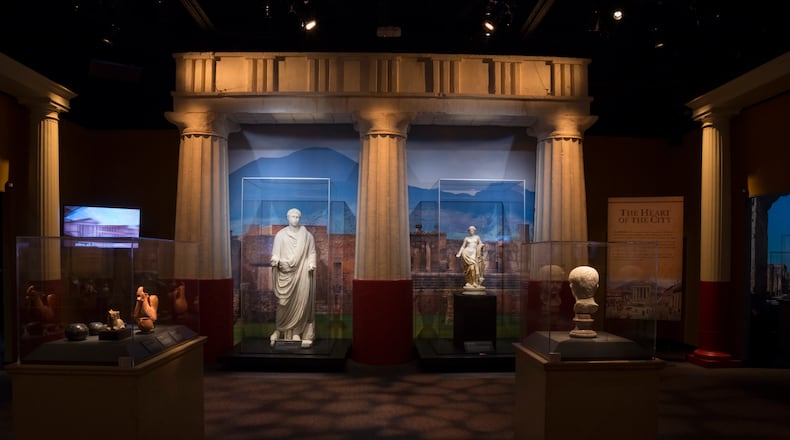On loan from the National Archaeological Museum of Naples in Italy, the traveling exhibit will be on display through July 28.
The real-life story dates back to Aug. 24 in 79 CE when the bustling port city of Pompeii was buried by the catastrophic eruption of Mount Vesuvius. It’s estimated that 2,000 people lost their lives. The city remained buried under 30 feet of ash for more than 1,700 years.
Credit: Darryl W. Moran
Credit: Darryl W. Moran
“The sudden disaster that destroyed the city also preserved it,” said John Norman, president of World Heritage Exhibitions who introduced the show to the media. He said the objects on display will transport visitors to a Roman villa, a market, a temple, a theater, Roman baths and more.
“The exhibition concludes with a dramatic and solemn presentation of the world-famous body casts, each with its own personal and unique story.”
When archaeologist Giuseppe Fiorelli excavated the city between 1860 and 1875, he discovered the bodies of people and animals smothered by ash disintegrated, leaving cavities in the hardened ash. Fiorelli and his team poured liquid plaster into these voids, creating casts that capture the victims of Pompeii in exactly the positions they assumed when they realized their end was nearing.
Those bodies are both upsetting and fascinating to see.
One of the most dramatic and sobering presentations in the exhibit is the eerily effective multi-media theater simulation that captures the day when the town of 20,000 was destroyed. Visitors will learn that at the peak of the eruption, magma, ash and gas were released from the volcano at a rate of 100,000 tons every second, traveling upward at the speed of a jet plane to reach 33 kilometers in height — 3.5 times the height of Mount Everest.
Patrons will watch the incredible pyroclastic surge, the extremely hot and fast-moving mixture of volcanic material made up of deadly gasses and ash. In just two minutes, the city streets were covered in almost eight feet of ash.
Other highlights
In Roman times, the city of Pompeii was best known as a vacation resort for Roman nobility. On display are mosaics and frescoes; gladiator helmets, armor and weapons; a ship’s anchor; lamps, jugs, cups, plates and other household objects, furniture and tools.
Many of the objects look much like those we use.
Professions seem familiar and range from farmers and shopkeepers to restaurant owners. (Because the lower classes in Pompeii had no kitchens in their homes, they apparently ate out a lot.)
Guests will be surprised to see there was even graffiti in ancient times. (“Marcus loves Julia.”) There’s a carbonized loaf of bread left exactly as its owner baked it. And guests will learn some weird facts: in order to bleach their patrons’ clothing, the professional cleaners placed large containers outside their establishments with citizens encouraged to relieve themselves in the jugs. Turns out, the urine served as a natural ammonia.
Local connections to Pompeii
Most aren’t aware that there are some close local connections to Pompeii, and those are part of the exhibit. The University of Cincinnati’s Steven Ellis, with help from his UC graduate students, has conducted some of the most extensive US-based excavations at Pompeii. The team is digging and mapping more than two city blocks and revealing centuries of the city’s urban history.
“What we’re seeing here are artifacts from the very wealthiest Pompeians and some of the very poorest as well,” Ellis said about the Cincinnati exhibit. “What strikes me is that these oil paintings and mosaics come from people’s living rooms, from their bedrooms. You can see the plates that they ate from and the pots that they cooked the food in. There’s a sense of immediacy about Pompeii.”
Credit: ALISA INNOCENTI 412-654-4027
Credit: ALISA INNOCENTI 412-654-4027
At the same time Pompeii was destroyed, the ancient city of Herculaneum was destroyed as well. One of the videos shows the terrific work done by University of Kentucky researchers who’ve been able to resurrect a vast library of carbonized Herculaneum papyrus scrolls. The team employs cutting-edge artificial intelligence (AI) and machine learning to read and uncover ancient texts.
Added attractions
One of the new additions is a holographic gladiator combat experience that’s fun to watch.
Exhibit patrons may also “fly over” Pompeii thanks to the museum’s Birdly virtual reality experience. They will gaze down at the amphitheaters, temples, brothels and forums.
Meredith Moss is a contributing writer for Cox First Media. Have an arts event or story idea to share with her? Email meredith.moss@coxinc.com.
How to go
What: “Pompeii: The Exhibition”
Where: Cincinnati Museum Center, 1301 Western Ave., Cincinnati
Hours: 10 a.m.-5 p.m. Thursday through Monday. Closed Tuesday and Wednesday. Through July 28
Other: Allow about two hours to view the exhibit
Admission: $23.50 for adults; $19.50 for Children; $21.50 for seniors. Members pay $17.50 for adults and $13.50 for children
More: cincymuseum.org/pompeii
About the Author



